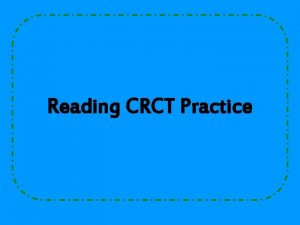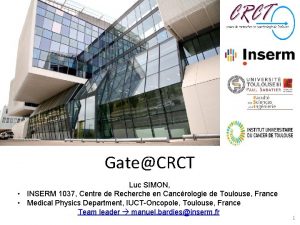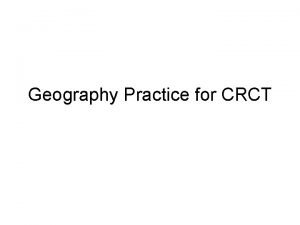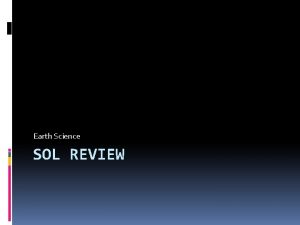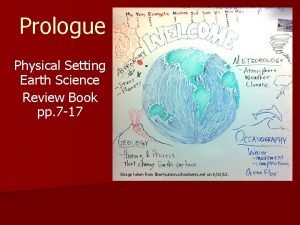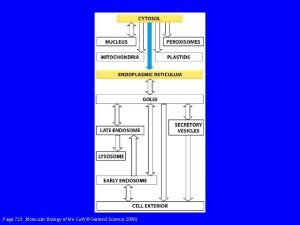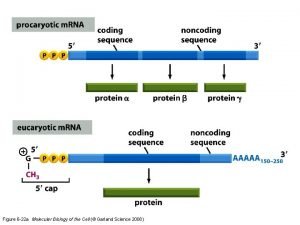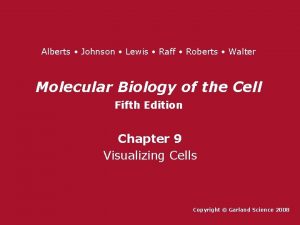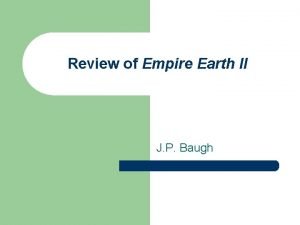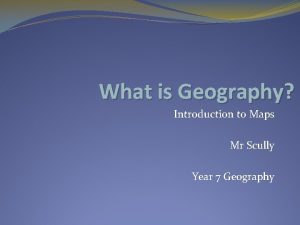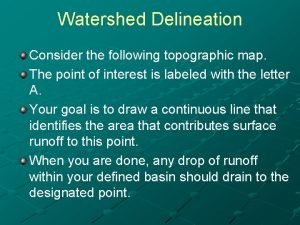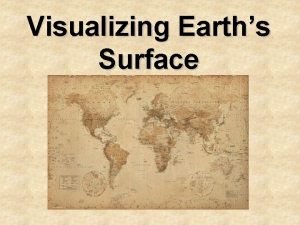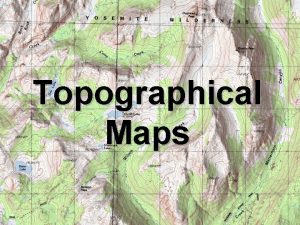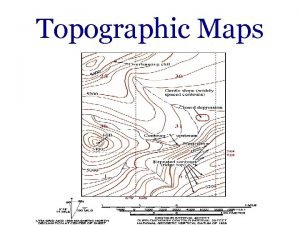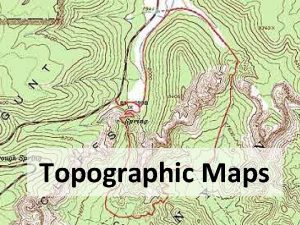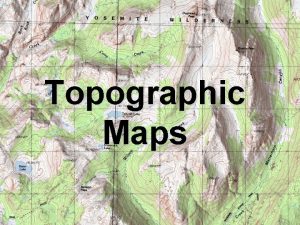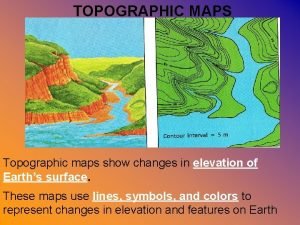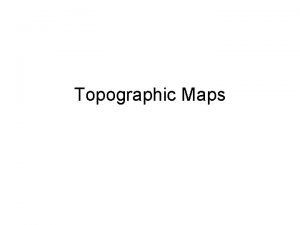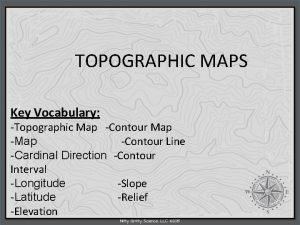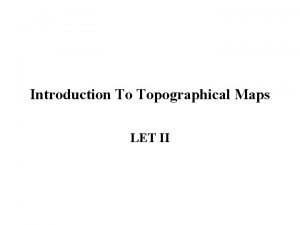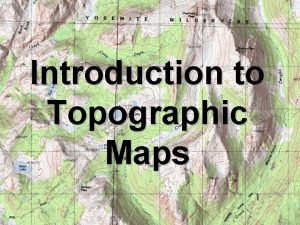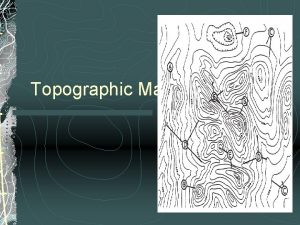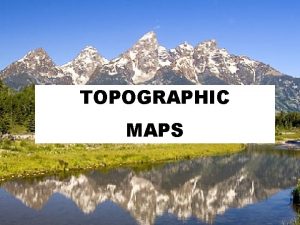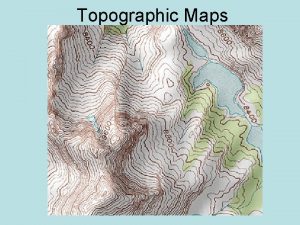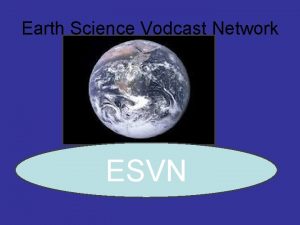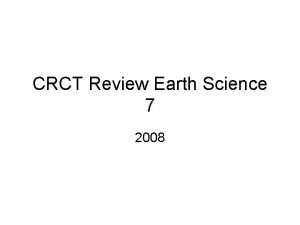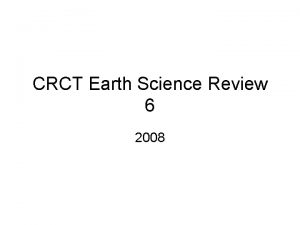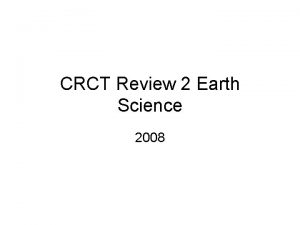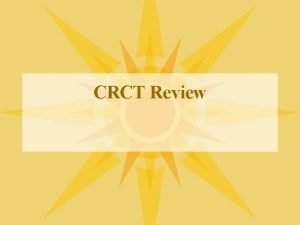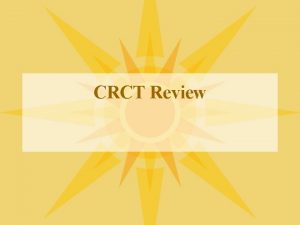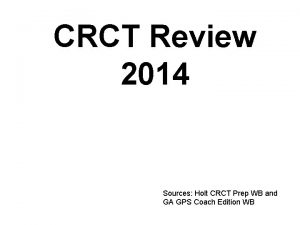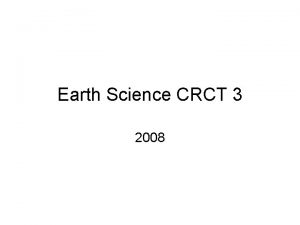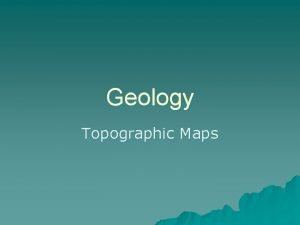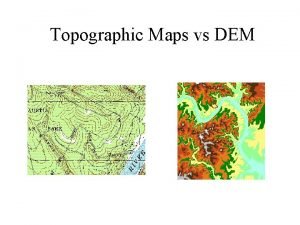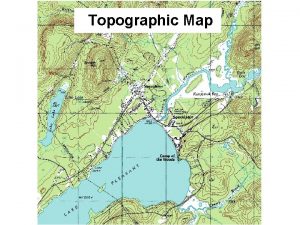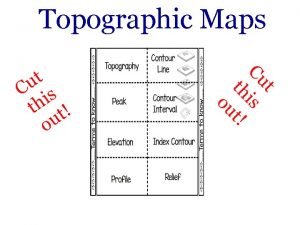Earth Science CRCT Review 4 2008 1 Topographic


























- Slides: 26

Earth Science CRCT Review 4 2008

• 1. Topographic maps are primarily used to show which of the following features? • A the shapes of continents and oceans • B lines of latitude and longitude • C highways and other roads • D the shape and size of surface features

Use the map to answer question 8. 2. Which of the paths marked on the map would you choose if you did not want to climb up or down hills? A path A C path C B path B D path D

• 3. Lines that connect points of equal elevation on topographic maps are called • A index contours. • B contour intervals. • C contour lines. • D relief.

Use the map to answer question 4. 4. Which point on the topographic map has the lowest elevation? A point A C point C B point B D point D

• 5. Which of the following definitions best describes a mineral? • A a substance that cannot be separated or broken down into simpler substances by chemical means • B a substance made up of atoms of two or more different elements joined by chemical bonds • C a naturally formed, inorganic solid that has a definite crystalline structure • D a solid whose atoms, ions, or molecules are arranged in a definite pattern

• 6. Which of the following substances is a mineral? • A coal, which forms from the remains of living things • B fluorite, which is a crystalline solid with the chemical formula Ca. F 2 • C obsidian, which is a volcanic glass and is not crystalline • D brass, which is a metal that is made by humans

Use the table to answer question 4. • 7. On the Mohs hardness scale, which of the following minerals is harder than topaz? • A apatite • B talc • C corundum • D quartz

• 8. Which of the following is NOT a way to reduce the impact of mining? • A recycling products that are made from minerals • B reducing the use of minerals to make products • C reclaiming land that has been disturbed by mining • D inventing new things to make out of minerals

• 9. Which of the following minerals can be identified by taste? • A magnetite • B fluorite • C calcite • D halite

• 10. Minerals such as gypsum and halite form • A from hot water solutions. • B when a rock is altered by metamorphism. • C when bodies of salt water evaporate. • D from the cooling of magma that rises upward through the crust.

• 11. Why are gemstones valuable? • A They can be used in concrete and to buildings. • B They are good conductors of heat and electricity. • C They are beautiful and rare. • D They taste good.

12. What is the difference between an element, a mineral, and a rock?

• • 13. Igneous rock forms when A magma cools and hardens. B minerals crystallize out of water. C heat and pressure change the composition and texture of a rock. • D natural cement binds rock fragments together.

Use the diagram to answer question 2. • 14. Which of the following processes occurs at point C on the diagram of the rock cycle? • A deposition • B uplift • C heat and pressure • D melting and cooling

• 15. Volcanic activity on Earth’s surface most likely results in the formation of which of the following types of rock? • A intrusive igneous rock • B extrusive igneous rock • C clastic sedimentary rock • D chemical sedimentary rock

• 16. How does clastic sedimentary rock form? • A Rock fragments are cemented together by a mineral such as calcite or quartz. • B Dissolved minerals crystallize out of solution in water to form solid minerals. • C Heat and pressure turn partially decomposed plant material into rock. • D Skeletons of sea animals that collected on the ocean floor are cemented together.

• 17. Stratification occurs as the result of which of the following processes? • A the cooling and solidification of magma • B the partial or complete melting of rock • C the deformation of rock by heat and pressure • D the deposition of sediments in a body of water

• 18. Which of the four rock samples in the table most likely formed in the process of regional metamorphism? • A Sample A • B Sample B • C Sample C • D Sample D

• 19. Buried rock is exposed at Earth’s surface by the combination of which two processes? • A weathering and deposition • B uplift and erosion • C erosion and deposition • D deposition and uplift

• 20. Which of the following processes forms sediment? • A deposition • B weathering • C erosion • D compaction and cementation

• 21. Rock in which the composition and texture of the rock have been changed by heat and pressure is called • A felsic rock. • B mafic rock. • C igneous rock. • D metamorphic rock.

• 22. Which of the following is one way to conserve water? • A using geothermal energy • B using hydroelectric energy • C keeping lakes and rivers free of pollution • D leaving the faucet on while brushing one’s teeth

• 23. What process releases the energy that is used in nuclear power plants to generate electrical energy? • A the burning of radioactive fuel • B the reaction of hydrogen and oxygen to form water • C the splitting of radioactive nuclei into two or more smaller nuclei • D the joining of two or more nuclei to form a larger nucleus

• 24. . Astronomers usually measure the distance from Earth to the Moon in • A. meters. B. kilometers. C. light-years. D. fathoms.

• 25. If you could look at the deep ocean floor, which is the best description of what you would see? • A. high mountains and deep valleys B. flat, silt-covered, lifeless regions C. coral reefs with many varieties of life D. ocean ridges with active volcanoes
 Crct practice
Crct practice Crct cmh
Crct cmh What country is this
What country is this 2008 2008
2008 2008 Earth science practical review
Earth science practical review End of semester test environmental science b edmentum
End of semester test environmental science b edmentum Earth science sol
Earth science sol Earth science review book
Earth science review book Earth science sol review
Earth science sol review Earth science prologue review
Earth science prologue review Eric’s favourite .......... is science.
Eric’s favourite .......... is science. Cardiolipina
Cardiolipina Fosfatasi
Fosfatasi Garland science 2008
Garland science 2008 Empire earth ii review
Empire earth ii review What is contour lines in geography
What is contour lines in geography Topographic map watershed delineation
Topographic map watershed delineation Hachured contour lines on a topographic map represent
Hachured contour lines on a topographic map represent A topographic map is a two dimensional model
A topographic map is a two dimensional model Topographic map worksheet answer key
Topographic map worksheet answer key Interpreting topographic maps worksheet
Interpreting topographic maps worksheet A topographic map is a two dimensional model
A topographic map is a two dimensional model Maps that show changes in elevation of earth’s surface
Maps that show changes in elevation of earth’s surface How to read a contour map
How to read a contour map Topography vocabulary
Topography vocabulary Introduction of topographic map
Introduction of topographic map A topographic map is a two dimensional model
A topographic map is a two dimensional model
